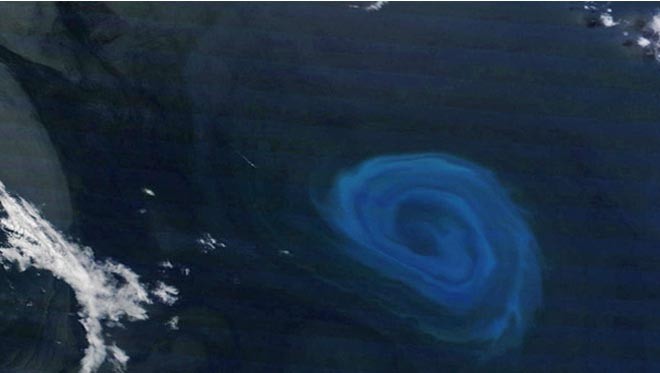Could you sail through this? Giant underwater storm detected
by Sail-World Cruising round-up on 24 Feb 2012

Underwater storm below Africa - 80 nautical miles across SW
Could you sail through this? The answer is yes, even though this is an underwater storm that rivals the scale and size of a tropical cyclone, this storm is actually a deep eddy and the blue colour is created by blooms of phytoplankton, fertilised by the nutrient-rich deep water drawn up by the 80 nautical-mile-wide eddy.
This eddy in this amazing image, photographed by NASA's Terra satellite on Boxing Day last year and only recently released, is about four hundred nautical miles from the coast of Africa in the southern Indian Ocean.
MODIS (or Moderate Resolution Imaging Spectroradiometer) is a key instrument aboard NASA’s Terra (EOS AM) satellite. Terra MODIS views the entire Earth’s surface every 1 to 2 days, acquiring data in 36 spectral bands. These data improve our understanding of global dynamics and processes occurring on the land, in the ocean, and in the lower atmosphere.
NASA launched Terra back in 2003 as part of a multinational effort to monitor the spread of pollution around the Earth through a 15-year lifecycle. Although taking this photo was not Terra's mission it´s an awesome sight to behold.
The counter-clockwise anticyclonic structure of the eddy resembles a hurricane or typhoon, but does not disturb the surface water and unlike storms on the surface, brings nourishment rather than destruction.
'Eddies are the internal weather of the sea,' said Dennis McGillicuddy, an oceanographer at the Woods Hole Oceanographic Institution in Massachusetts.
And also unlike atmospheric storms, ocean eddies can last for months, even up to a year. The largest ones can contain up to 1,200 cubic miles (5,000 cubic kilometers) of water.
The nutrient-drawing power of eddies can supply the relatively barren waters of the open ocean with nutrients, creating 'oases in the oceanic desert,' according to McGillicuddy.
The eddy imaged here likely peeled off from the Agulhas Current, which flows along the southeastern coast of Africa and around the tip of South Africa. Agulhas eddies, also called 'current rings,' tend to be among the largest in the world, transporting warm, salty water from the Indian Ocean to the South Atlantic.
To learn more about these ocean eddies, http://www.whoi.edu/oceanus/viewArticle.do?id=10592!click_here.
If you want to link to this article then please use this URL: www.sail-world.com/94236

